Top 10 Worst Bushfires In Australia Over The Past Century
Although wildfires can be a natural part of the ecology, Australians still bear catastrophic loss of life and injuries, as well as property and farmland damage from these blazes. Let’s look back at the worst bushfires in Australia over the past century to see their devastating damage, their causes, and their lasting impact.
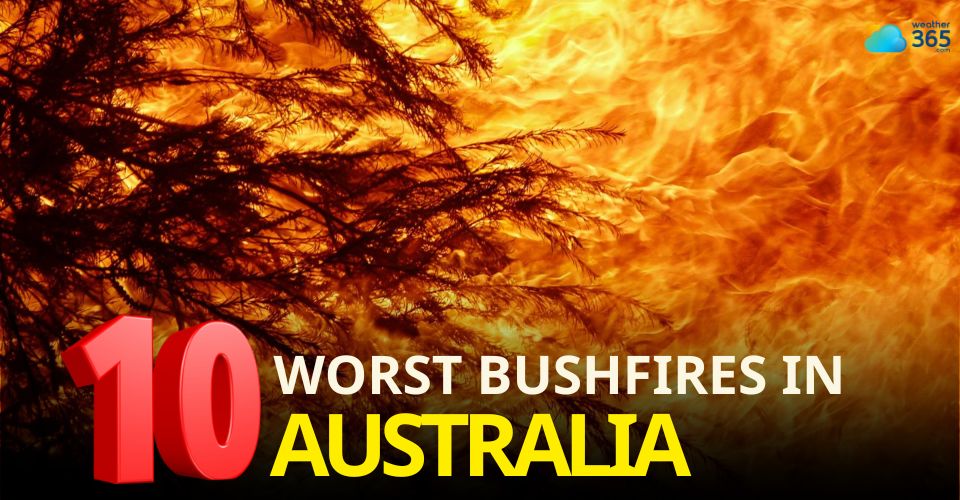
Top 10 worst bushfires in Australia
- Brushfires in Australia
- TOP 10 worst bushfires in Australia
- Black Saturday bushfires 2009
- Black Summer fires 2019-2020
- Black Friday bushfires 1939
- Gippsland fires 2003
- Eastern Victorian fires 2006-2007
- Ash Wednesday bushfires 1983
- Tasmania bushfires 1967
- Canberra firestorm 2003
- Millfield & Greta fires 1944
- Cudgewa fires 2020
- Where do bushfires often occur in Australia?
Brushfires in Australia
Bushfires in Australia are among the most destructive natural disasters the country faces, fueled by extreme heat, strong winds, and prolonged dry conditions.
In recent years, these fires have reached unprecedented scales, devastating communities, ecosystems, and infrastructure.
During one of the most severe bushfire seasons, more than 50 fires burned simultaneously across New South Wales (NSW) and Victoria.
Multiple states declared emergency and disaster warnings.
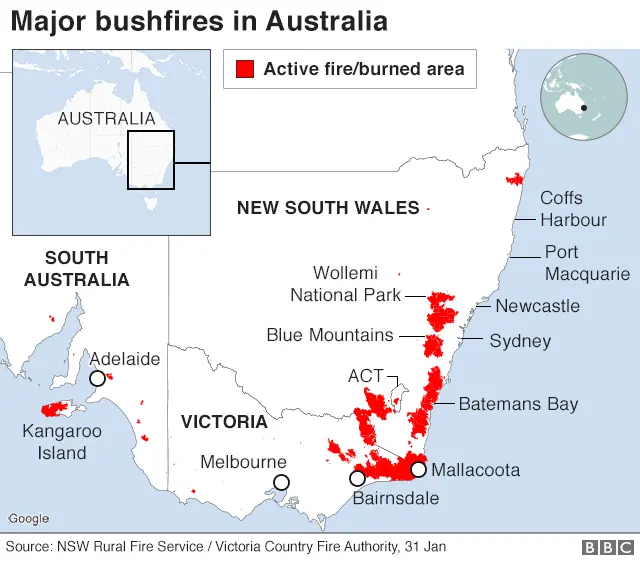
Major bushfires in Australia
The toll has been staggering, with at least 33 people, including four firefighters, losing their lives.
More than 11 million hectares (110,000 sq km) of bushland, forests, and national parks were destroyed, along with over 2,000 homes in NSW alone.
Thousands of residents were forced to evacuate, and countless wildlife species faced catastrophic habitat loss.
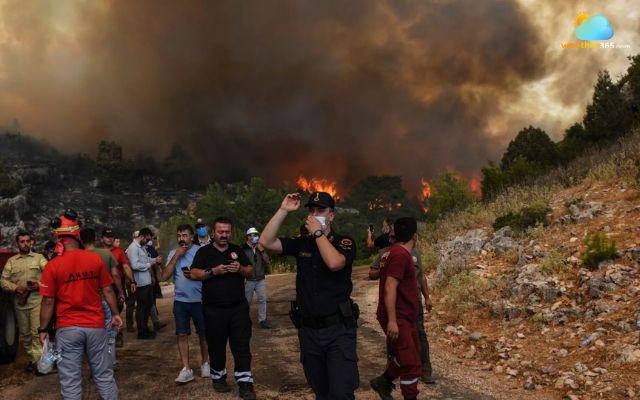
Thousands of people evacuated from wildfires
In Canberra, bushfires threatened the city’s outskirts, forcing airport closures and emergency evacuations.
The fires’ intensity in regions like Tuggeranong and parts of Victoria required large-scale firefighting operations, supported by over 1,600 firefighters and military resources, including troops, ships, and aircraft.
Despite temporary relief from cooler weather and rainfall, hot and windy conditions repeatedly reignited the threat, underscoring the ongoing challenge of managing bushfire risk in Australia’s changing climate.
Read more:
TOP 10 worst bushfires in Australia
Australia has faced some of the most devastating bushfires in history, leaving behind tragic losses and irreversible damage to the environment, communities, and wildlife.
This list of the top 10 worst bushfires in Australia highlights the deadliest and most destructive fire events over the past century.
Black Saturday bushfires 2009
The Black Saturday bushfires in Australia occurred on 7 February 2009 in Victoria, marking one of the deadliest fire disasters in the nation’s history.
On that day, temperatures soared above 46°C with wind gusts over 100 km/h, creating catastrophic fire conditions.
Fires were sparked by various causes, including lightning strikes, fallen power lines, and suspected arson.
The blazes swept through rural towns with devastating speed, killing 173 people, injuring over 400, and destroying more than 2,000 homes. Around 450,000 hectares of land were burned, wiping out wildlife habitats and farmland.
This disaster prompted major reforms in Australia’s bushfire preparedness, building standards, and emergency warning systems.
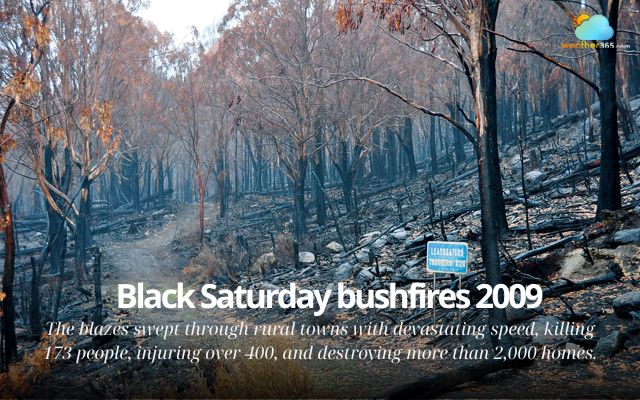
The Black Saturday bushfires in 2009
Black Summer fires 2019-2020
The Black Summer fires of 2019–2020 were one of the worst bushfires in Australia’s history.
The bushfires were a result of extreme heat, prolonged drought, and dry vegetation.
Beginning in June 2019 and lasting until May 2020, the fires devastated vast regions, with over 18 million hectares burned nationwide.
In New South Wales, 5.4 million hectares were scorched, and temperatures reached record highs.
The disaster caused 33 direct fatalities and an estimated 400 deaths from smoke inhalation.
Millions of animals were killed or displaced. Consequently, biodiversity is threatened on an unprecedented scale.
The fires also released massive amounts of CO₂, worsening climate change impacts.
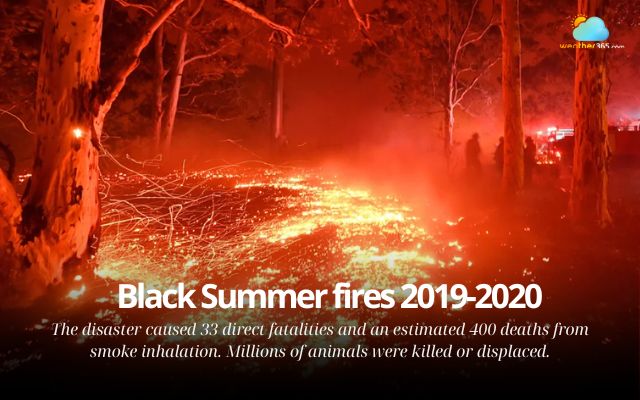
The Black Summer fires in 2019-2020
Black Friday bushfires 1939
The Black Friday bushfires of 13 January 1939 were among the most devastating in Australia’s history.
It struck Victoria after a prolonged drought and severe water shortages.
In the weeks leading up to the disaster, high temperatures, strong winds, and low humidity created extreme fire conditions.
Many blazes were ignited by lightning, negligence, and poorly managed land clearing, with some controlled burns unintentionally spreading.
The fires ravaged vast bushland near Melbourne, killing 71 people and destroying 650 homes. About 2 million hectares of forest were lost, along with countless livestock.
A subsequent Royal Commission spurred significant reforms in bushfire prevention, firefighting coordination, and land management.
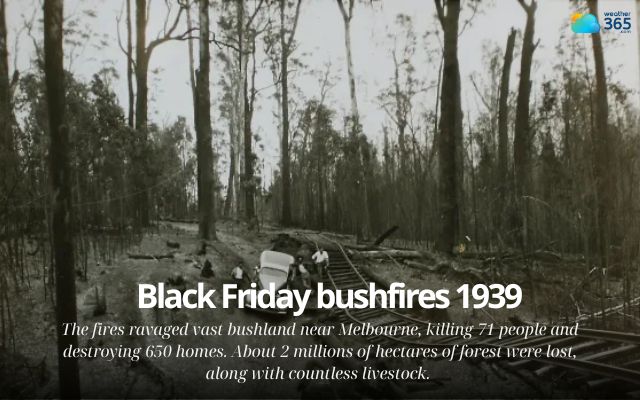
The Black Friday bushfires in 1939
Gippsland fires 2003
The Gippsland fires of 2003 swept across eastern Victoria, ignited in late January by lightning strikes during severe drought conditions.
Fanned by intense heat, low humidity, and strong winds, the fires raged for nearly two months, burning over 1.3 million hectares of forest, farmland, and national park.
More than 40 homes and numerous outbuildings were destroyed, and thousands of livestock were lost.
While no human lives were lost, communities endured weeks of hazardous smoke, displacement, and economic hardship.
The disaster prompted significant reviews of bushfire preparedness in Victoria, leading to stronger fire management strategies and improved community warning systems.
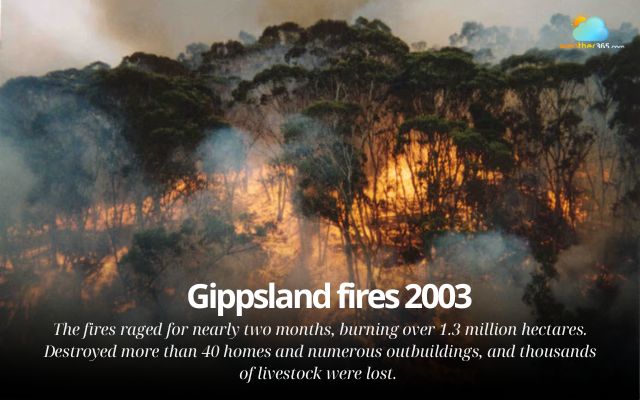
The Gippsland fires in 2003
Eastern Victorian fires 2006-2007
The Eastern Victorian fires of 2006–2007 were among Australia’s longest-running bushfire events.
It started in early December 2006 after lightning strikes ignited multiple blazes in remote alpine areas.
Prolonged drought, scorching temperatures, and strong winds allowed the fires to merge into massive fire complexes.
Burning for 69 days, they ignited over 1.2 million hectares of forest and farmland, and dozens of homes were lost. There were thousands of firefighters battling the blazes.
The Eastern Victorian fires had significant impacts on agriculture, wildlife, and tourism.
While there were no large-scale fatalities, the disaster caused severe air quality issues across Victoria.

The Eastern Victorian fires in 2006-2007
Ash Wednesday bushfires 1983
The Ash Wednesday bushfires of 16 February 1983 devastated Victoria and South Australia.
This was fueled by widespread drought, gale-force winds, scorching temperatures, and low humidity.
The extreme conditions allowed fires, mostly ignited by accidents and arson, to spread rapidly through residential and rural areas near Melbourne and Adelaide.
In just one day, the fires caused 75 deaths, injured thousands, and left communities in ruins.
Nearly 1,900 homes were destroyed, along with vast areas of farmland and forest.
The disaster prompted major reforms in emergency communication, firefighting strategies, and community preparedness, becoming a turning point in Australia’s approach to managing severe bushfire risks.
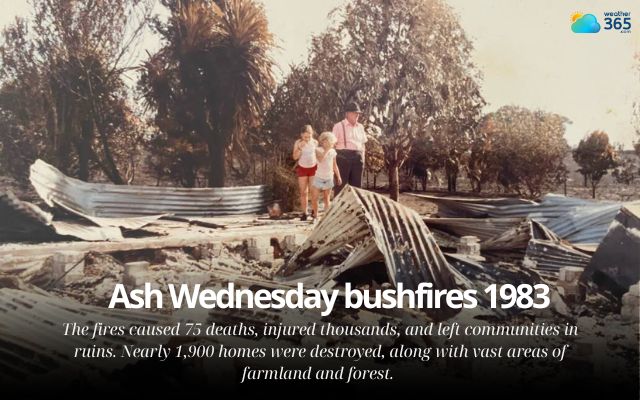
The Ash Wednesday bushfires in 1983
Tasmania bushfires 1967
The Tasmania bushfires, also known as the Black Tuesday fires, struck on 7 February 1967 after an unusually abundant spring left forest floors covered in dry litter.
Combined with strong northerly winds and extreme heat, at least 80 fires ignited across southern Tasmania.
The blazes swept through the south-east coast and came within just 2 km of central Hobart.
In total, 62 people lost their lives, nearly 1,300 homes were destroyed, and thousands were left homeless.
The disaster remains one of Australia’s deadliest bushfires.
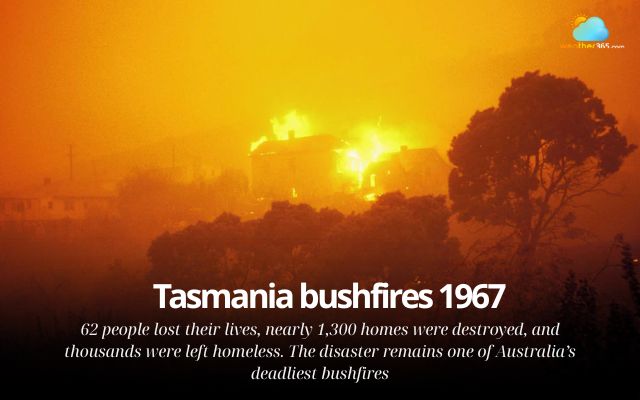
The Tasmania bushfires in 1967
Canberra firestorm 2003
The Canberra firestorm of 2003 was still one of the worst bushfires in Australia.
After weeks of drought, extreme heat, and lightning strikes, multiple fires broke out in the Brindabella Ranges.
Strong winds pushed the flames into suburban Canberra, creating a devastating firestorm.
The disaster killed 4 people, injured over 400, and destroyed or damaged more than 500 homes, leaving thousands displaced.
Key infrastructure, including the Mount Stromlo Observatory, was lost.
In total, over 160,000 hectares were burned.
The tragedy prompted significant changes to ACT’s emergency response, fire preparedness, and community warning systems.

The Canberra firestorm in 2003
Millfield & Greta fires 1944
The Millfield & Greta fires were part of a devastating bushfire season in New South Wales.
It occurred during January–February 1944 during an extreme heat, drought, and strong winds period.
The fires swept through the Hunter Valley towns of Millfield and Greta.
It destroyed hundreds of homes and devastated farmland. There were about 30 deaths, and thousands were left homeless.
Livestock losses were severe, crippling the local agricultural economy.
The blazes were also fueled by dry grasslands and exacerbated by limited firefighting resources during World War II.
These fires remain one of NSW’s deadliest bushfire events of the 20th century.
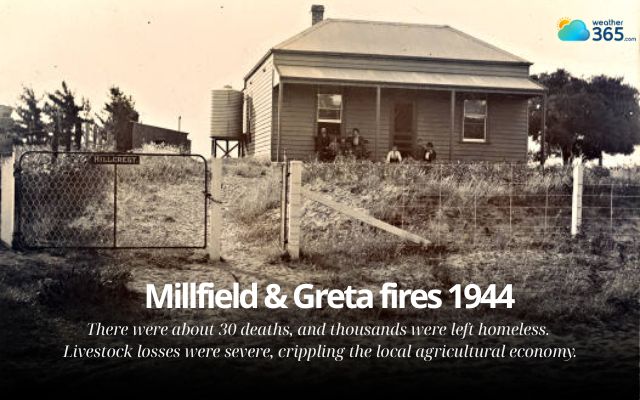
The Millfield & Greta fires in 1944
Cudgewa fires 2020
The Cudgewa fires of 2020 occurred during Australia’s catastrophic Black Summer bushfire season, peaking in early January 2020.
Sparked by lightning strikes in the surrounding Alpine regions of Victoria and fueled by extreme heat, strong winds, and prolonged drought, the fires tore through the small rural community of Cudgewa near the NSW border.
Dozens of homes, farms, and local infrastructure were destroyed, forcing mass evacuations.
Livestock losses were immense, severely impacting the agricultural livelihoods of residents.
While no fatalities were recorded in the town itself, the emotional and economic toll was severe, with recovery efforts continuing long after the flames subsided.
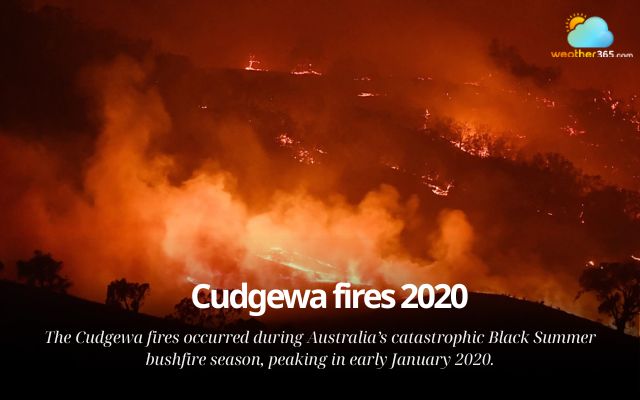
The Cudgewa fires in 2020
|
Rank |
Name |
Date |
State(s) |
Deaths |
Area Burned |
|
1 |
Black Saturday Bushfires |
Feb 2009 |
Victoria |
173 |
~450,000 ha |
|
2 |
2019–2020 Black Summer Fires |
Sep 2019 – Feb 2020 |
NSW, VIC, SA, QLD, ACT |
33 (direct) + 400 (indirect) |
~18.6 million ha |
|
3 |
Black Friday Bushfires |
Jan 1939 |
Victoria |
71 |
~2 million ha |
|
4 |
Gippsland Fires |
Jan–Mar 2003 |
Victoria |
0 |
~1.3 million ha |
|
5 |
Eastern Victorian Fires |
Dec 2006 – Feb 2007 |
Victoria |
1 |
~1.2 million ha |
|
6 |
Ash Wednesday Bushfires |
Feb 1983 |
SA, Victoria |
75 |
~418,000 ha |
|
7 |
Tasmania Bushfires |
Feb 1967 |
Tasmania |
62 |
~264,000 ha |
|
8 |
Canberra Firestorm |
Jan 2003 |
ACT |
4 |
~160,000 ha |
|
9 |
Millfield & Greta Fires |
Oct 1944 |
New South Wales |
10 |
Unknown |
|
10 |
Cudgewa Fires |
Jan 2020 |
Victoria |
Several |
Part of Black Summer |
Where do bushfires often occur in Australia?
According to the Australian Government, bushfires are most frequently recorded in New South Wales and the Northern Territory, although they can occur in almost any region of the continent when conditions are favorable.
Australia’s generally hot, dry climate, combined with recurring droughts, makes the country highly vulnerable to fire year-round.
Fire seasons vary by region due to differing weather patterns:
👉 In southern Australia, the peak danger period is during summer and autumn.
👉 In New South Wales and southern Queensland, the highest risk typically falls in spring and early summer.
👉 In the Northern Territory, most fires occur in winter and spring.
Grassland fires frequently arise after periods of abundant rainfall, which encourages thick vegetation growth that later dries out under intense heat.
Bushfires typically happen after periods of little rainfall, when both light and large fuel loads in eucalypt forests have dried up.
This combination of environmental factors means that, regardless of location, large parts of Australia remain under constant threat of bushfires throughout the year.
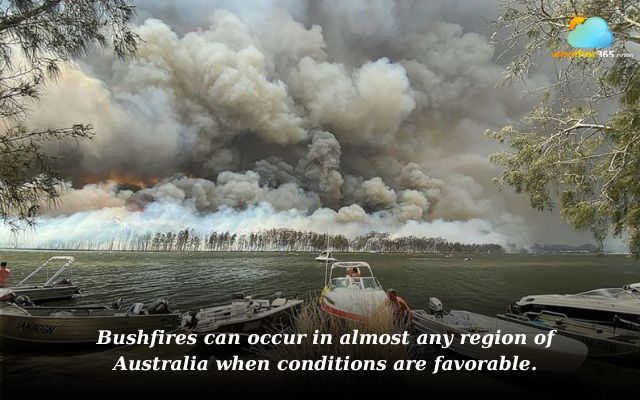
Bushfires can happen anywhere in Australia
Conclusion
The worst Bushfires in Australia have left an undeniable mark on the nation’s history, causing immense loss of life, property, and biodiversity. From the catastrophic Black Saturday fires to the devastating Black Summer, each disaster highlights the urgent need for stronger fire prevention strategies, climate change action, and community preparedness. By learning from the past, Australia can find solutions, minimize the impact of such disasters, and protect its unique environment.

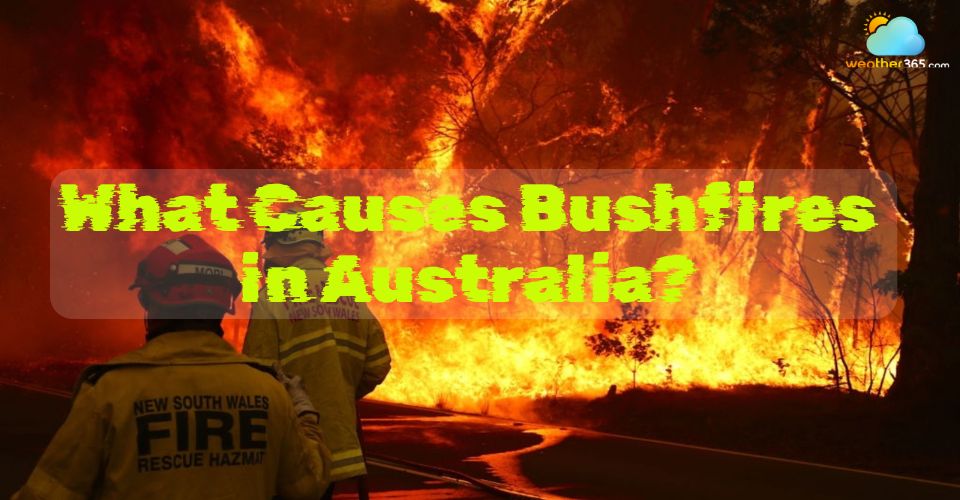
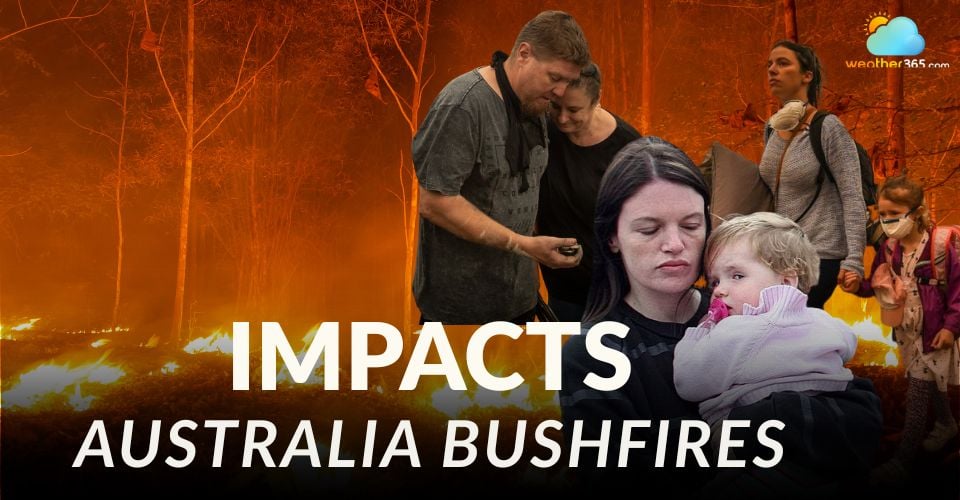
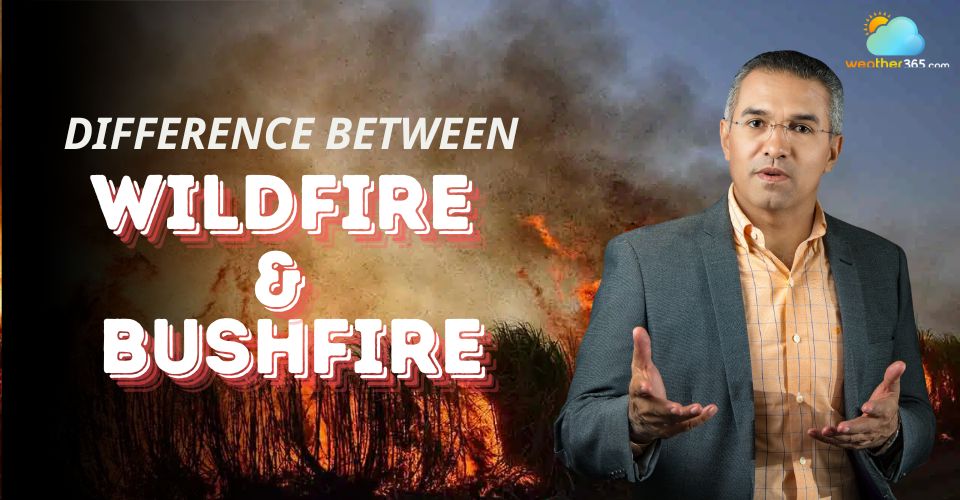
0 Comment
Leave a comment
Your email address will not be published. Required fields are marked *